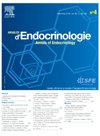Cellular and molecular effects of exposure to BPA alternatives in hippocampal neurons derived from human induced pluripotent cells
IF 2.9
3区 医学
Q3 ENDOCRINOLOGY & METABOLISM
引用次数: 0
Abstract
Introduction
Bisphenol A (BPA) is used in epoxy resins and polycarbonate containers for storage of foods and beverages. BPA has been classified as a substance of very high concern by the European Chemical Agency. Adverse effects were identified on learning and memory, via an estrogenic mode of action. Due to BPA restrictions, substitutes have been developed, yet data on their toxicity are limited.
Materials and methods
In this project, we are using hippocampal neurons derived from human induced pluripotent stem cells (hiPSCs) to assess the effects of a chronic treatment of BPA and substitutes at cellular and molecular levels.
Results and discussion
Inhibition of WNT, TGFβ and BMP signalling pathways, followed by WNT activation, induces differentiation of hiPSCs into hippocampal neural progenitors (hNPCs) within 28 days. BDNF treatment promotes neuronal maturation. RT-qPCR analyses showed that hiPSCs expressing octamer-binding transcription factor 4- (OCT-4) differentiated with high efficiency into hNPCs, expressing NESTIN and hippocampal progenitor markers prospero homeobox 1 (PROX1) and zinc finger and BTB domain containing 20 (ZBT20). Neuronal marker microtubule associated protein 2 (MAP2), and hippocampal markers ELAV like RNA binding protein 2 (ELAVL2) and glutamate ionotropic receptor kainate 4 (GRIK4) were expressed in mature neurons at day 43. hNPCs were treated chronically (14 days) with increasing concentrations (0.001, 0.01, 0.1, 1, 10, and 100 μM) of BPA and substitutes BPAP, BPE and BPZ. All bisphenols showed a concentration-dependent decrease in cell viability, with a significant decrease at 100 μM for BPA, BPAP and BPZ and from 10 μm for BPE. Then, hNPCs were treated with non-toxic doses for 14 days. RNA has been extracted, and gene expression analysis of potential key gene targets is underway. Immunocytochemistry for β-III tubulin has been performed to analyze neuronal morphology. Protein levels of presynaptic and postsynaptic markers will also be quantified to measure the impact of treatments on synaptic plasticity.
暴露于双酚a替代品对人类诱导多能细胞海马神经元的细胞和分子效应
双酚A (BPA)用于环氧树脂和聚碳酸酯容器中,用于储存食品和饮料。BPA已被欧洲化学品管理局列为高度关注的物质。通过雌激素的作用模式,发现了对学习和记忆的不良影响。由于双酚a的限制,替代品已经开发出来,但其毒性的数据有限。材料和方法在本项目中,我们使用来自人类诱导多能干细胞(hiPSCs)的海马神经元,在细胞和分子水平上评估双酚a及其替代品的慢性治疗效果。结果与讨论抑制WNT、TGFβ和BMP信号通路,随后激活WNT,可诱导hiPSCs在28天内分化为海马神经祖细胞(hNPCs)。BDNF治疗促进神经元成熟。RT-qPCR分析显示,表达OCT-4的hiPSCs高效分化为hNPCs,表达NESTIN和海马祖细胞标记物prospero homeobox 1 (PROX1)和锌指和BTB结构域20 (ZBT20)。43 d成熟神经元中表达神经元标记物微管相关蛋白2 (MAP2)、海马标记物ELAV样RNA结合蛋白2 (ELAVL2)和谷氨酸嗜离子受体kainate 4 (GRIK4)。长期处理hNPCs (14 d),增加BPA和代用品BPAP、BPE和BPZ浓度(0.001、0.01、0.1、1、10和100 μM)。所有双酚类物质均呈浓度依赖性降低细胞活力,BPA、BPAP和BPZ在100 μM时显著降低,BPE在10 μM时显著降低。然后,用无毒剂量给hNPCs治疗14天。RNA已被提取,潜在关键基因靶点的基因表达分析正在进行中。免疫细胞化学对β-III微管蛋白进行分析神经元形态。突触前和突触后标记物的蛋白水平也将被量化,以衡量治疗对突触可塑性的影响。
本文章由计算机程序翻译,如有差异,请以英文原文为准。
求助全文
约1分钟内获得全文
求助全文
来源期刊

Annales d'endocrinologie
医学-内分泌学与代谢
CiteScore
4.40
自引率
6.50%
发文量
311
审稿时长
50 days
期刊介绍:
The Annales d''Endocrinologie, mouthpiece of the French Society of Endocrinology (SFE), publishes reviews, articles and case reports coming from clinical, therapeutic and fundamental research in endocrinology and metabolic diseases. Every year, it carries a position paper by a work-group of French-language endocrinologists, on an endocrine pathology chosen by the Society''s Scientific Committee. The journal is also the organ of the Society''s annual Congress, publishing a summary of the symposia, presentations and posters. "Les Must de l''Endocrinologie" is a special booklet brought out for the Congress, with summary articles that are always very well received. And finally, we publish the high-level instructional courses delivered during the Henri-Pierre Klotz International Endocrinology Days. The Annales is a window on the world, keeping alert clinicians up to date on what is going on in diagnosis and treatment in all the areas of our specialty.
 求助内容:
求助内容: 应助结果提醒方式:
应助结果提醒方式:


